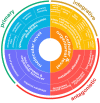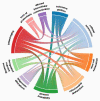Aging Hallmarks and Progression and Age-Related Diseases: A Landscape View of Research Advancement
- PMID: 38095562
- PMCID: PMC10767750
- DOI: 10.1021/acschemneuro.3c00531
Aging Hallmarks and Progression and Age-Related Diseases: A Landscape View of Research Advancement
Abstract
Aging is a dynamic, time-dependent process that is characterized by a gradual accumulation of cell damage. Continual functional decline in the intrinsic ability of living organisms to accurately regulate homeostasis leads to increased susceptibility and vulnerability to diseases. Many efforts have been put forth to understand and prevent the effects of aging. Thus, the major cellular and molecular hallmarks of aging have been identified, and their relationships to age-related diseases and malfunctions have been explored. Here, we use data from the CAS Content Collection to analyze the publication landscape of recent aging-related research. We review the advances in knowledge and delineate trends in research advancements on aging factors and attributes across time and geography. We also review the current concepts related to the major aging hallmarks on the molecular, cellular, and organismic level, age-associated diseases, with attention to brain aging and brain health, as well as the major biochemical processes associated with aging. Major age-related diseases have been outlined, and their correlations with the major aging features and attributes are explored. We hope this review will be helpful for apprehending the current knowledge in the field of aging mechanisms and progression, in an effort to further solve the remaining challenges and fulfill its potential.
Keywords: Aging; brain aging; epigenetic; inflammaging; longevity; senescence; stem cell; telomere.
Conflict of interest statement
The authors declare no competing financial interest.
Figures













Similar articles
-
Antiaging Strategies and Remedies: A Landscape of Research Progress and Promise.ACS Chem Neurosci. 2024 Feb 7;15(3):408-446. doi: 10.1021/acschemneuro.3c00532. Epub 2024 Jan 12. ACS Chem Neurosci. 2024. PMID: 38214973 Free PMC article. Review.
-
Does aging need its own program, or is the program of development quite sufficient for it? Stationary cell cultures as a tool to search for anti-aging factors.Curr Aging Sci. 2013 Feb;6(1):14-20. doi: 10.2174/18746098112059990009. Curr Aging Sci. 2013. PMID: 23387885 Review.
-
Deciphering the aging process through single-cell cytometric technologies.Cytometry A. 2024 Aug;105(8):621-638. doi: 10.1002/cyto.a.24852. Epub 2024 Jun 7. Cytometry A. 2024. PMID: 38847116 Free PMC article. Review.
-
Connecting aging biology and inflammation in the omics era.J Clin Invest. 2022 Jul 15;132(14):e158448. doi: 10.1172/JCI158448. J Clin Invest. 2022. PMID: 35838044 Free PMC article. Review.
-
Hallmarks of Aging in Macrophages: Consequences to Skin Inflammaging.Cells. 2021 May 26;10(6):1323. doi: 10.3390/cells10061323. Cells. 2021. PMID: 34073434 Free PMC article. Review.
Cited by
-
Aging is a Risk Factor for Rheumatoid Arthritis in Rats: Therapeutic Potential of 4‑(Phenylselanyl)-2H-chromen-2-one.ACS Omega. 2025 Jun 9;10(24):25990-26005. doi: 10.1021/acsomega.5c02655. eCollection 2025 Jun 24. ACS Omega. 2025. PMID: 40584342 Free PMC article.
-
Healthcare on the brink: navigating the challenges of an aging society in the United States.NPJ Aging. 2024 Apr 6;10(1):22. doi: 10.1038/s41514-024-00148-2. NPJ Aging. 2024. PMID: 38582901 Free PMC article. Review.
-
Roles and mechanisms of histone methylation in vascular aging and related diseases.Clin Epigenetics. 2025 Feb 23;17(1):35. doi: 10.1186/s13148-025-01842-y. Clin Epigenetics. 2025. PMID: 39988699 Free PMC article. Review.
-
Psychometric evaluation of the translated arabic version of the geriatrics health behavior questionnaire (GHBQ) for geriatric nurses: a cross-sectional study.BMC Nurs. 2024 Aug 13;23(1):552. doi: 10.1186/s12912-024-02164-9. BMC Nurs. 2024. PMID: 39135070 Free PMC article.
-
Unravelling Convergent Signaling Mechanisms Underlying the Aging-Disease Nexus Using Computational Language Analysis.Curr Issues Mol Biol. 2025 Mar 14;47(3):189. doi: 10.3390/cimb47030189. Curr Issues Mol Biol. 2025. PMID: 40136443 Free PMC article.
References
-
- World Population Ageing. https://www.un.org/en/development/desa/population/publications/pdf/agein... (accessed Jan 30, 2023).
Publication types
MeSH terms
LinkOut - more resources
Full Text Sources

